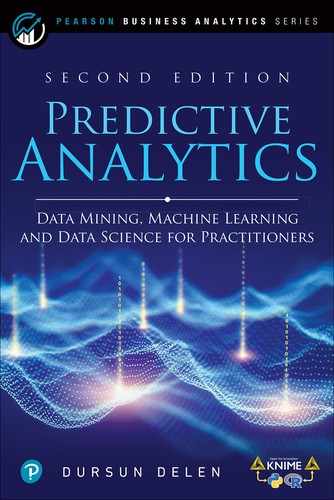Book Description
Using predictive analytics techniques, decision-makers can uncover hidden patterns and correlations in their data, and leverage this insight to improve a wide range of business decisions. In Predictive Analytics: Data Mining, Machine Learning and Data Science for Practitioners, Dr. Dursun Delen illuminates state-of-the-art best practices for predictive analytics for both business professionals and students. Delen’s holistic approach covers all this, and more:
Data mining processes, methods, and techniques
The role and management of data
Predictive analytics tools and metrics
Techniques for text and web mining, and for sentiment analysis
Integration with cutting-edge Big Data approaches
Throughout, Delen promotes understanding by presenting numerous conceptual illustrations, motivational success stories, failed projects that teach important lessons, and simple, hands-on tutorials that set this guide apart from competitors.
Table of Contents
- Cover Page
- Title Page
- Contents
- Table of Contents
- Chapter 1. Introduction to Predictive Analytics
- Chapter 2. Introduction to Predictive Analytics and Data Mining
- Chapter 3. Standardized Processes for Predictive Analytics
- Chapter 4. Data and Methods for Predictive Analytics
- The Nature of Data in Data Analytics
- Preprocessing of Data for Analytics
- Data Mining Methods
- Prediction
- Classification
- Decision Trees
- Cluster Analysis for Data Mining
- k-Means Clustering Algorithm
- Association
- Apriori Algorithm
- Data Mining and Predictive Analytics Misconceptions and Realities
- Summary
- References
- Chapter 5. Algorithms for Predictive Analytics
- Chapter 6. Advanced Topics in Predictive Modeling
- Model Ensembles
- Bias-Variance Tradeoff in Predictive Analyztics
- Imbalanced Data Problem in Predictive Analytics
- Explainability of Machine Learning Models for Predictive Analytics
- Application Case: To Imprison or Not to Imprison—A Predictive Analytics-Based Decision Support System for Drug Courts
- Summary
- References
- Chapter 7. Text Analytics, Topic Modeling, and Sentiment Analysis
- Chapter 8. Big Data for Predictive Analytics
- Where Does Big Data Come From?
- The Vs That Define Big Data
- Fundamental Concepts of Big Data
- The Business Problems That Big Data Analytics Addresses
- Big Data Technologies
- Data Scientists
- Big Data and Stream Analytics
- Data Stream Mining
- Application Example: Big Data for Political Campaigns
- Summary
- References
- Chapter 9. Deep Learning and Cognitive Computing
- Introduction to Deep Learning
- Basics of “Shallow” Neural Networks
- Elements of an Artificial Neural Network
- Deep Neural Networks
- Convolutional Neural Networks
- Recurrent Networks and Long Short-Term Memory Networks
- Computer Frameworks for Implementation of Deep Learning
- Cognitive Computing
- Application Case: Fighting Fraud with Deep Learning
- Summary
- References
- Appendix A. KNIME and the Landscape of Tools for Business Analytics and Data Science
